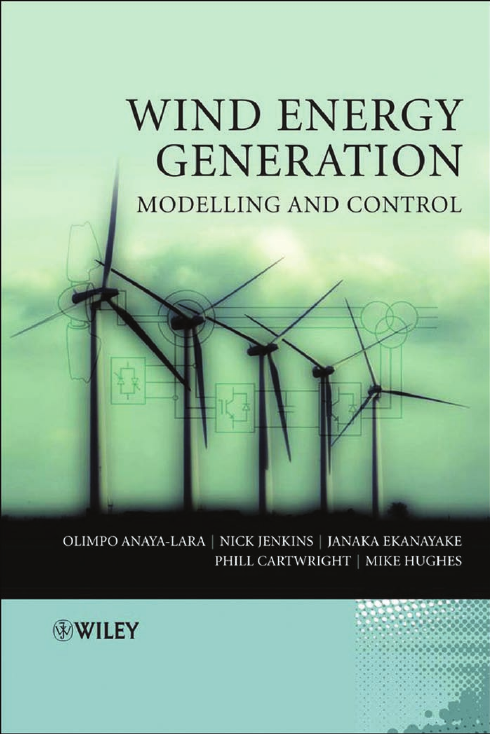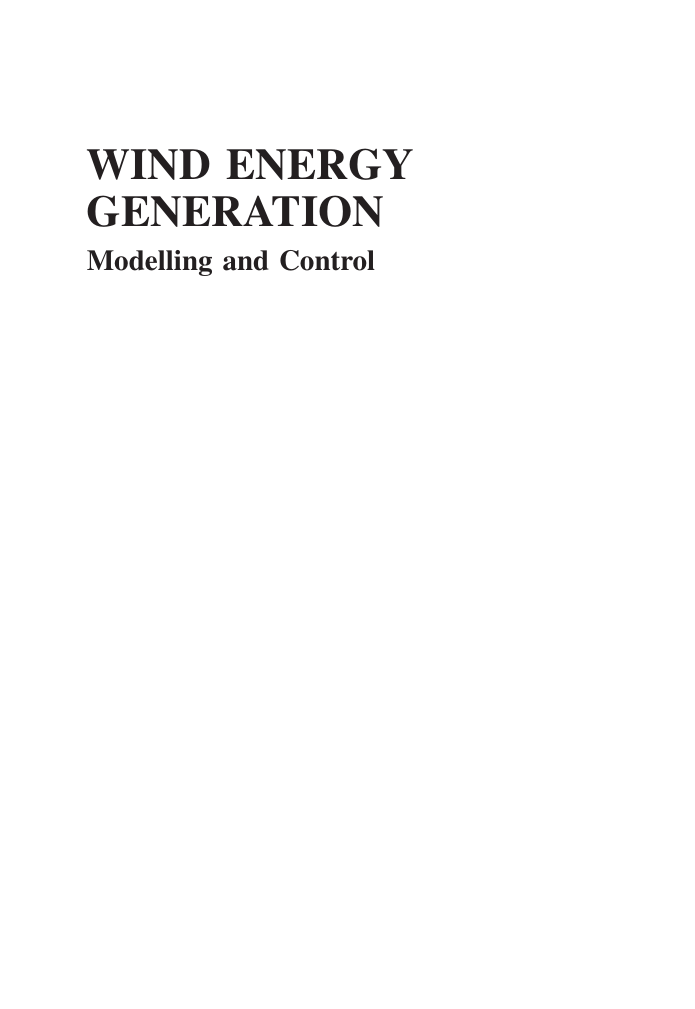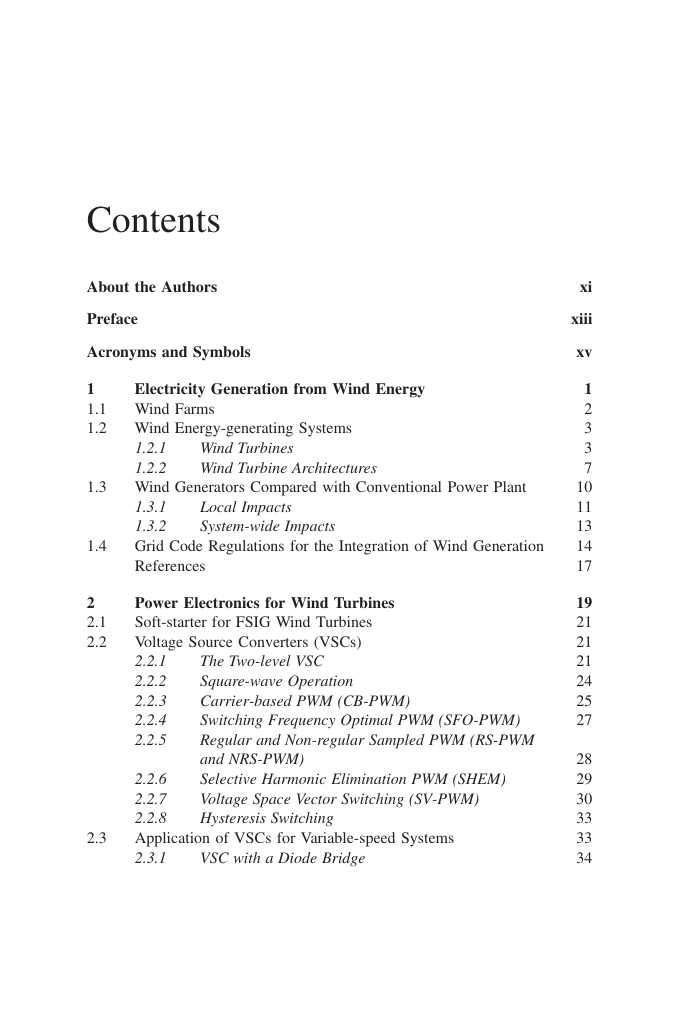Wind Energy Generation
Contents
About the Authors
Preface
Acronyms and Symbols
1 Electricity Generation from Wind Energy
1.1 Wind Farms
1.2 Wind Energy-generating Systems
1.2.1 Wind Turbines
1.2.2 Wind Turbine Architectures
1.3 Wind Generators Compared with Conventional Power Plant
1.3.1 Local Impacts
1.3.2 System-wide Impacts
1.4 Grid Code Regulations for the Integration of Wind Generation
References
2 Power Electronics for Wind Turbines
2.1 Soft-starter for FSIG Wind Turbines
2.2 Voltage Source Converters (VSCs)
2.2.1 The Two-level VSC
2.2.2 Square-wave Operation
2.2.3 Carrier-based PWM (CB-PWM)
2.2.4 Switching Frequency Optimal PWM (SFO-PWM)
2.2.5 Regular and Non-regular Sampled PWM (RS-PWM and NRS-PWM)
2.2.6 Selective Harmonic Elimination PWM (SHEM)
2.2.7 Voltage Space Vector Switching (SV-PWM)
2.2.8 Hysteresis Switching
2.3 Application of VSCs for Variable-speed Systems
2.3.1 VSC with a Diode Bridge
2.3.2 Back-to-Back VSCs
References
3 Modelling of Synchronous Generators
3.1 Synchronous Generator Construction
3.2 The Air-gap Magnetic Field of the Synchronous Generator
3.3 Coil Representation of the Synchronous Generator
3.4 Generator Equations in the dq Frame
3.4.1 Generator Electromagnetic Torque
3.5 Steady-state Operation
3.6 Synchronous Generator with Damper Windings
3.7 Non-reduced Order Model
3.8 Reduced-order Model
3.9 Control of Large Synchronous Generators
3.9.1 Excitation Control
3.9.2 Prime Mover Control
References
4 Fixed-speed Induction Generator (FSIG)-based Wind Turbines
4.1 Induction Machine Construction
4.1.1 Squirrel-cage Rotor
4.1.2 Wound Rotor
4.2 Steady-state Characteristics
4.2.1 Variations in Generator Terminal Voltage
4.3 FSIG Configurations for Wind Generation
4.3.1 Two-speed Operation
4.3.2 Variable-slip Operation
4.3.3 Reactive Power Compensation Equipment
4.4 Induction Machine Modelling
4.4.1 FSIG Model as a Voltage Behind a Transient Reactance
4.5 Dynamic Performance of FSIG Wind Turbines
4.5.1 Small Disturbances
4.5.2 Performance During Network Faults
References
5 Doubly Fed Induction Generator (DFIG)-based Wind Turbines
5.1 Typical DFIG Configuration
5.2 Steady-state Characteristics
5.2.1 Active Power Relationships in the Steady State
5.2.2 Vector Diagram of Operating Conditions
5.3 Control for Optimum Wind Power Extraction
5.4 Control Strategies for a DFIG
5.4.1 Current-mode Control (PVdq)
5.4.2 Rotor Flux Magnitude and Angle Control
5.5 Dynamic Performance Assessment
5.5.1 Small Disturbances
5.5.2 Performance During Network Faults
References
6 Fully Rated Converter-based (FRC) Wind Turbines
6.1 FRC Synchronous Generator-based (FRC-SG) Wind Turbine
6.1.1 Direct-driven Wind Turbine Generators
6.1.2 Permanent Magnets Versus Electrically Excited Synchronous Generators
6.1.3 Permanent Magnet Synchronous Generator
6.1.4 Wind Turbine Control and Dynamic Performance Assessment
6.2 FRC Induction Generator-based (FRC-IG) Wind Turbine
6.2.1 Steady-state Performance
6.2.2 Control of the FRC-IG Wind Turbine
6.2.3 Performance Characteristics of the FRC-IG Wind Turbine
References
7 Influence of Rotor Dynamics on Wind Turbine Operation
7.1 Blade Bending Dynamics
7.2 Derivation of Three-mass Model
7.2.1 Example: 300 kW FSIG Wind Turbine
7.3 Effective Two-mass Model
7.4 Assessment of FSIG and DFIG Wind Turbine Performance
Acknowledgement
References
8 Influence of Wind Farms on Network Dynamic Performance
8.1 Dynamic Stability and its Assessment
8.2 Dynamic Characteristics of Synchronous Generation
8.3 A Synchronizing Power and Damping Power Model of a Synchronous Generator
8.4 Influence of Automatic Voltage Regulator on Damping
8.5 Influence on Damping of Generator Operating Conditions
8.6 Influence of Turbine Governor on Generator Operation
8.7 Transient Stability
8.8 Voltage Stability
8.9 Generic Test Network
8.10 Influence of Generation Type on Network Dynamic Stability
8.10.1 Generator 2 – Synchronous Generator
8.10.2 Generator 2 – FSIG-based Wind Farm
8.10.3 Generator 2 – DFIG-based Wind Farm (PVdq Control)
8.10.4 Generator 2 – DFIG-based Wind Farm (FMAC Control)
8.10.5 Generator 2 – FRC-based Wind Farm
8.11 Dynamic Interaction of Wind Farms with the Network
8.11.1 FSIG Influence on Network Damping
8.11.2 DFIG Influence on Network Damping
8.12 Influence of Wind Generation on Network Transient Performance
8.12.1 Generator 2 – Synchronous Generator
8.12.2 Generator 2 – FSIG Wind Farm
8.12.3 Generator 2 – DFIG Wind Farm
8.12.4 Generator 2 – FRC Wind Farm
References
9 Power Systems Stabilizers and Network Damping Capability of Wind Farms
9.1 A Power System Stabilizer for a Synchronous Generator
9.1.1 Requirements and Function
9.1.2 Synchronous Generator PSS and its Performance Contributions
9.2 A Power System Stabilizer for a DFIG
9.2.1 Requirements and Function
9.2.2 DFIG-PSS and its Performance Contributions
9.3 A Power System Stabilizer for an FRC Wind Farm
9.3.1 Requirements and Functions
9.3.2 FRC–PSS and its Performance Contributions
References
10 The Integration of Wind Farms into the Power System
10.1 Reactive Power Compensation
10.1.1 Static Var Compensator (SVC)
10.1.2 Static Synchronous Compensator (STATCOM)
10.1.3 STATCOM and FSIG Stability
10.2 HVAC Connections
10.3 HVDC Connections
10.3.1 LCC–HVDC
10.3.2 VSC–HVDC
10.3.3 Multi-terminal HVDC
10.3.4 HVDC Transmission – Opportunities and Challenges
10.4 Example of the Design of a Submarine Network
10.4.1 Beatrice Offshore Wind Farm
10.4.2 Onshore Grid Connection Points
10.4.3 Technical Analysis
10.4.4 Cost Analysis
10.4.5 Recommended Point of Connection
Acknowledgement
References
11 Wind Turbine Control for System Contingencies
11.1 Contribution of Wind Generation to Frequency Regulation
11.1.1 Frequency Control
11.1.2 Wind Turbine Inertia
11.1.3 Fast Primary Response
11.1.4 Slow Primary Response
11.2 Fault Ride-through (FRT)
11.2.1 FSIGs
11.2.2 DFIGs
11.2.3 FRCs
11.2.4 VSC–HVDC with FSIG Wind Farm
11.2.5 FRC Wind Turbines Connected Via a VSC–HVDC
References
Appendix A: State–Space Concepts and Models
Appendix B: Introduction to Eigenvalues and Eigenvectors
Appendix C: Linearization of State Equations
Appendix D: Generic Network Model Parameters
Index
















 2023年江西萍乡中考道德与法治真题及答案.doc
2023年江西萍乡中考道德与法治真题及答案.doc 2012年重庆南川中考生物真题及答案.doc
2012年重庆南川中考生物真题及答案.doc 2013年江西师范大学地理学综合及文艺理论基础考研真题.doc
2013年江西师范大学地理学综合及文艺理论基础考研真题.doc 2020年四川甘孜小升初语文真题及答案I卷.doc
2020年四川甘孜小升初语文真题及答案I卷.doc 2020年注册岩土工程师专业基础考试真题及答案.doc
2020年注册岩土工程师专业基础考试真题及答案.doc 2023-2024学年福建省厦门市九年级上学期数学月考试题及答案.doc
2023-2024学年福建省厦门市九年级上学期数学月考试题及答案.doc 2021-2022学年辽宁省沈阳市大东区九年级上学期语文期末试题及答案.doc
2021-2022学年辽宁省沈阳市大东区九年级上学期语文期末试题及答案.doc 2022-2023学年北京东城区初三第一学期物理期末试卷及答案.doc
2022-2023学年北京东城区初三第一学期物理期末试卷及答案.doc 2018上半年江西教师资格初中地理学科知识与教学能力真题及答案.doc
2018上半年江西教师资格初中地理学科知识与教学能力真题及答案.doc 2012年河北国家公务员申论考试真题及答案-省级.doc
2012年河北国家公务员申论考试真题及答案-省级.doc 2020-2021学年江苏省扬州市江都区邵樊片九年级上学期数学第一次质量检测试题及答案.doc
2020-2021学年江苏省扬州市江都区邵樊片九年级上学期数学第一次质量检测试题及答案.doc 2022下半年黑龙江教师资格证中学综合素质真题及答案.doc
2022下半年黑龙江教师资格证中学综合素质真题及答案.doc